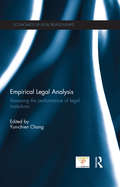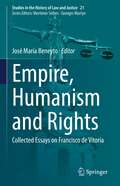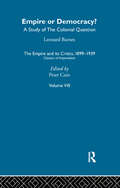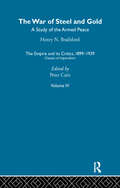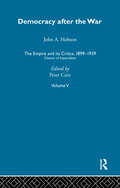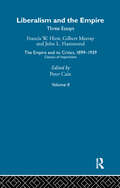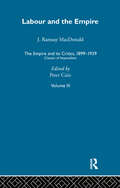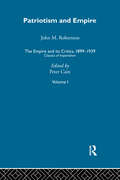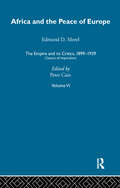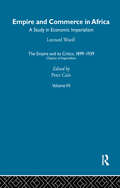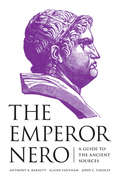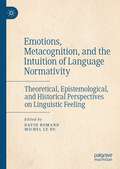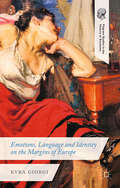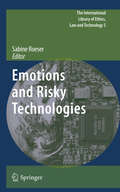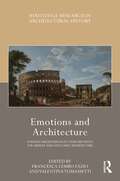- Table View
- List View
Empirical Legal Analysis: Assessing the performance of legal institutions (The Economics of Legal Relationships)
by Yun-Chien ChangThis innovative volume explores empirical legal issues around the world. While legal studies have traditionally been worked on and of letters and with a normative bent, in recent years quantitative methods have gained traction by offering a brand new perspective of understanding law. That is, legal scholars have started to crunch numbers, not letters, to tease out the effects of law on the regulated industries, citizens, or judges in reality. In this edited book, authors from leading institutions in the U.S., Europe, and Asia investigate legal issues in South Africa, Argentina, the U.S., Israel, Taiwan, and other countries. Using original data in a variety of statistical tools (from the most basic chi-square analysis to sophisticated two-stage least square regression models), contributors to this book look into the judicial behaviours in Taiwan and Israel, the determinants of constitutional judicial systems in 100 countries, and the effect of appellate court decisions on media competition. In addition, this book breaks new ground in informing important policy debates. Specifically, how long should we incarcerate criminals? Should the medical malpractice liability system be reformed? Do police reduce crime? Why is South Africa’s democratic transition viable? With solid data as evidence, this volume sheds new light on these issues from a road more and more frequently taken—what is known as "empirical legal studies/analysis." This book should be useful to students, practitioners and professors of law, economics and public policy in many countries who seek to understand their legal system from a different, and arguably more scientific, perspective.
Empirical Legal Analysis: Assessing the performance of legal institutions (The Economics of Legal Relationships)
by Yun-Chien ChangThis innovative volume explores empirical legal issues around the world. While legal studies have traditionally been worked on and of letters and with a normative bent, in recent years quantitative methods have gained traction by offering a brand new perspective of understanding law. That is, legal scholars have started to crunch numbers, not letters, to tease out the effects of law on the regulated industries, citizens, or judges in reality. In this edited book, authors from leading institutions in the U.S., Europe, and Asia investigate legal issues in South Africa, Argentina, the U.S., Israel, Taiwan, and other countries. Using original data in a variety of statistical tools (from the most basic chi-square analysis to sophisticated two-stage least square regression models), contributors to this book look into the judicial behaviours in Taiwan and Israel, the determinants of constitutional judicial systems in 100 countries, and the effect of appellate court decisions on media competition. In addition, this book breaks new ground in informing important policy debates. Specifically, how long should we incarcerate criminals? Should the medical malpractice liability system be reformed? Do police reduce crime? Why is South Africa’s democratic transition viable? With solid data as evidence, this volume sheds new light on these issues from a road more and more frequently taken—what is known as "empirical legal studies/analysis." This book should be useful to students, practitioners and professors of law, economics and public policy in many countries who seek to understand their legal system from a different, and arguably more scientific, perspective.
Empire, Humanism and Rights: Collected Essays on Francisco de Vitoria (Studies in the History of Law and Justice #21)
by José María BeneytoThis book deals with Vitoria, Charles V and Erasmus. Vitoria’s ideas had a major influence on Charles V and his European and American policy. In turn, Erasmus’ humanism was decisive in the formation of a new international order intellectually discussed by Vitoria and put into practice by the Emperor.Shedding new light on the influence of Francisco de Vitoria and Erasmus on Charles V’s imperial policy, the book’s goal is to explore the impact of Vitoria’s thought with regard to the history of, and contemporary issues in, international law, while also comparing his thinking with that of the well-known humanist Erasmus and assessing their respective influences on the imperial policy of Charles V.
The Empire and its Critics, 1899-1939: Classics of Imperialism
by Leonard BarnesThe eight books reprinted in this set played an important role in defining attitudes and expectations about imperialism on the British Left in the twentieth century. They are vital in understanding the transition from the liberal anti-imperialism of the nineteenth century to the more overtly socialist critiques of the twentieth.
The Empire and its Critics, 1899-1939: Classics of Imperialism
by Henry N. BrailsfordThe eight books reprinted in this set played an important role in defining attitudes and expectations about imperialism on the British Left in the twentieth century. They are vital in understanding the transition from the liberal anti-imperialism of the nineteenth century to the more overtly socialist critiques of the twentieth.
The Empire and its Critics, 1899-1939: Classics of Imperialism
by Peter CainThe eight books reprinted in this set played an important role in defining attitudes and expectations about imperialism on the British Left in the twentieth century. They are vital in understanding the transition from the liberal anti-imperialism of the nineteenth century to the more overtly socialist critiques of the twentieth.
The Empire and its Critics, 1899-1939: Classics of Imperialism
by Peter CainThe eight books reprinted in this set played an important role in defining attitudes and expectations about imperialism on the British Left in the twentieth century. They are vital in understanding the transition from the liberal anti-imperialism of the nineteenth century to the more overtly socialist critiques of the twentieth.
The Empire and its Critics, 1899-1939: Classics of Imperialism
by Peter CainThe eight books reprinted in this set played an important role in defining attitudes and expectations about imperialism on the British Left in the twentieth century. They are vital in understanding the transition from the liberal anti-imperialism of the nineteenth century to the more overtly socialist critiques of the twentieth.
The Empire and its Critics, 1899-1939: Classics of Imperialism
by Peter CainThe eight books reprinted in this set played an important role in defining attitudes and expectations about imperialism on the British Left in the twentieth century. They are vital in understanding the transition from the liberal anti-imperialism of the nineteenth century to the more overtly socialist critiques of the twentieth.
The Empire and its Critics, 1899-1939: Classics of Imperialism
by Peter CainThe eight books reprinted in this set played an important role in defining attitudes and expectations about imperialism on the British Left in the twentieth century. They are vital in understanding the transition from the liberal anti-imperialism of the nineteenth century to the more overtly socialist critiques of the twentieth.
The Empire and its Critics, 1899-1939: Classics of Imperialism
by Peter CainThe eight books reprinted in this set played an important role in defining attitudes and expectations about imperialism on the British Left in the twentieth century. They are vital in understanding the transition from the liberal anti-imperialism of the nineteenth century to the more overtly socialist critiques of the twentieth.
The Empire and its Critics, 1899-1939: Classics of Imperialism
by Peter CainThe eight books reprinted in this set played an important role in defining attitudes and expectations about imperialism on the British Left in the twentieth century. They are vital in understanding the transition from the liberal anti-imperialism of the nineteenth century to the more overtly socialist critiques of the twentieth.
The Empire and its Critics, 1899-1939: Classics of Imperialism
by Peter CainThe eight books reprinted in this set played an important role in defining attitudes and expectations about imperialism on the British Left in the twentieth century. They are vital in understanding the transition from the liberal anti-imperialism of the nineteenth century to the more overtly socialist critiques of the twentieth.
The Empire and its Critics, 1899-1939: Classics of Imperialism
by Francis W. HirstThe eight books reprinted in this set played an important role in defining attitudes and expectations about imperialism on the British Left in the twentieth century. They are vital in understanding the transition from the liberal anti-imperialism of the nineteenth century to the more overtly socialist critiques of the twentieth.
The Empire and its Critics, 1899-1939: Classics of Imperialism
by John A. HobsonThe eight books reprinted in this set played an important role in defining attitudes and expectations about imperialism on the British Left in the twentieth century. They are vital in understanding the transition from the liberal anti-imperialism of the nineteenth century to the more overtly socialist critiques of the twentieth.
The Empire and its Critics, 1899-1939: Classics of Imperialism
by J. Ramsay MacDonaldThe eight books reprinted in this set played an important role in defining attitudes and expectations about imperialism on the British Left in the twentieth century. They are vital in understanding the transition from the liberal anti-imperialism of the nineteenth century to the more overtly socialist critiques of the twentieth.
The Empire and its Critics, 1899-1939: Classics of Imperialism
by E. D. MorelThe eight books reprinted in this set played an important role in defining attitudes and expectations about imperialism on the British Left in the twentieth century. They are vital in understanding the transition from the liberal anti-imperialism of the nineteenth century to the more overtly socialist critiques of the twentieth.
The Empire and its Critics, 1899-1939: Classics of Imperialism
by John M. RobertsonThe eight books reprinted in this set played an important role in defining attitudes and expectations about imperialism on the British Left in the twentieth century. They are vital in understanding the transition from the liberal anti-imperialism of the nineteenth century to the more overtly socialist critiques of the twentieth.
The Empire and its Critics, 1899-1939: Classics of Imperialism
by Leonard WoolfThe eight books reprinted in this set played an important role in defining attitudes and expectations about imperialism on the British Left in the twentieth century. They are vital in understanding the transition from the liberal anti-imperialism of the nineteenth century to the more overtly socialist critiques of the twentieth.
The Emperor Nero: A Guide to the Ancient Sources
by Anthony A. Barrett Elaine Fantham John C. YardleyNero's reign (AD 54–68) witnessed some of the most memorable events in Roman history, such as the rebellion of Boudica and the first persecution of the Christians—not to mention Nero's murder of his mother, his tyranny and extravagance, and his suicide, which plunged the empire into civil war. The Emperor Nero gathers into a single collection the major sources for Nero's life and rule, providing students of Nero and ancient Rome with the most authoritative and accessible reader there is.The Emperor Nero features clear, contemporary translations of key literary sources along with translations and explanations of representative inscriptions and coins issued under Nero. The informative introduction situates the emperor's reign within the history of the Roman Empire, and the book's concise headnotes to chapters place the source material in historical and biographical context. Passages are accompanied by detailed notes and are organized around events, such as the Great Fire of Rome, or by topic, such as Nero's relationships with his wives. Complex events like the war with Parthia—split up among several chapters in Tacitus's Annals—are brought together in continuous narratives, making this the most comprehensible and user-friendly sourcebook on Nero available.
Emotions, Metacognition, and the Intuition of Language Normativity: Theoretical, Epistemological, and Historical Perspectives on Linguistic Feeling
by David Romand Michel Le DuThis book proposes a comprehensive discussion of the issue of linguistic feeling, the subject’s metalinguistic capacity to intuitively apprehend the normative – lexical, syntactic, morphological, phonological… – dimensions of a definite language he or she is acquainted with. The volume’s twelve contributions aim to revisit a concept that, through a fluctuating terminology (“Sprachgefühl,” “sentiment de la langue,” “linguistic intuitions,” etc.), had developed, since the late 18th century, within a variety of cultural contexts and research traditions, and whose theoretical, epistemological, and historical ins and outs had not been systematically explored so far. Beginning with a long opening chapter, the book consists of two parts, one tracing the multifaceted approaches to linguistic feeling from Herder to Wittgenstein, and one offering a representative overview of the debates about the issue at stake in current linguistics and philosophy, while addressing the question of the place of metacognition, normativity, and affectivity in language processes.
Emotions, Language and Identity on the Margins of Europe (Palgrave Studies in the History of Emotions)
by K. GiorgiWhen a word describing an emotion is said to be untranslatable, is that emotion untranslatable also? This unique study focuses on three word-concepts on the periphery of Europe, providing a wide-ranging survey of national identity and cultural essentialism, nostalgia, melancholy and fatalism, the production of memory and the politics of hope.
Emotions and Risky Technologies (The International Library of Ethics, Law and Technology #5)
by Sabine Roeser“Acceptable Risk” – On the Rationality (and Irrationality) of Emotional Evaluations of Risk What is “acceptable risk”? That question is appropriate in a number of different contexts, political, social, ethical, and scienti c. Thus the question might be whether the voting public will support a risky proposal or project, whether people will buy or accept a risky product, whether it is morally permissible to pursue this or that potentially harmful venture, or whether it is wise or prudent to test or try out some possibly dangerous hypothesis or product. But complicating all of these queries, the “sand in the machinery” of rational decision-making, are the emotions. It is often noted (but too rarely studied) that voters are swayed by their passions at least as much as they are convinced by rational arguments. And it is obvious to advertisers and retailers that people are seduced by all sorts of appeals to their vanities, their fears, their extravagant hopes, their insecurities. At least one major thread of ethical discourse, the one following Kant, minimizes the importance of the emotions (“the inclinations”) in favor of an emphatically rational decision-making process, and it is worth mulling over the fact that many of those who do not accept Kant’s ethical views more or less applaud his rejection of the “moral sentiment theory” of the time, promoted by such luminary philosophers as David Hume and Adam Smith.
Emotions and Architecture: Forging Mediterranean Cities Between the Middle Ages and Early Modern Time (Routledge Research in Architectural History)
by Francesca Lembo Fazio Valentina TomassettiEmotions and Architecture: Forging Mediterranean Cities Between the Middle Ages and Early Modern Time explores architecture as a medium to arouse or conceal emotions, to build consensus through shared values, or to reconnect the urban community to its alleged ancestry. The chapters in this edited collection outline how architectonic symbols, images, and structures were codified – and sometimes recast – to match or to arouse emotions awakened by wars, political dominance, pandemic challenges, and religion. As signs of spiritual and political power, these elements were embraced and modulated locally, providing an endorsement to authorities and rituals for the community. This volume provides an overview of the phenomenon across the Italian region, stressing the transnationality of selected symbols and their various declinations in local contexts. It deepens the issue of refitting symbols, artworks, and structures to arouse emotions by carefully analysing specific cases, such as the Septizodium in Rome, the Holy House of Loreto in Venice, and the reconstruction of L'Aquila. The collection, through its variegated contributions, offers a comprehensive view of the phenomenon: exploring the issue from political, social, religious, and public health perspectives, and seeking to propose a new definition of architecture as a visual emotional language. Together, the chapters show how the representation of virtues and emotions through architecture was part of a symbolic practice shared by many across the Italian context. This book will be of interest to researchers and students studying architectural history, the history of emotions, and the history of art.
Emotions and Architecture: Forging Mediterranean Cities Between the Middle Ages and Early Modern Time (Routledge Research in Architectural History)
Emotions and Architecture: Forging Mediterranean Cities Between the Middle Ages and Early Modern Time explores architecture as a medium to arouse or conceal emotions, to build consensus through shared values, or to reconnect the urban community to its alleged ancestry. The chapters in this edited collection outline how architectonic symbols, images, and structures were codified – and sometimes recast – to match or to arouse emotions awakened by wars, political dominance, pandemic challenges, and religion. As signs of spiritual and political power, these elements were embraced and modulated locally, providing an endorsement to authorities and rituals for the community. This volume provides an overview of the phenomenon across the Italian region, stressing the transnationality of selected symbols and their various declinations in local contexts. It deepens the issue of refitting symbols, artworks, and structures to arouse emotions by carefully analysing specific cases, such as the Septizodium in Rome, the Holy House of Loreto in Venice, and the reconstruction of L'Aquila. The collection, through its variegated contributions, offers a comprehensive view of the phenomenon: exploring the issue from political, social, religious, and public health perspectives, and seeking to propose a new definition of architecture as a visual emotional language. Together, the chapters show how the representation of virtues and emotions through architecture was part of a symbolic practice shared by many across the Italian context. This book will be of interest to researchers and students studying architectural history, the history of emotions, and the history of art.
